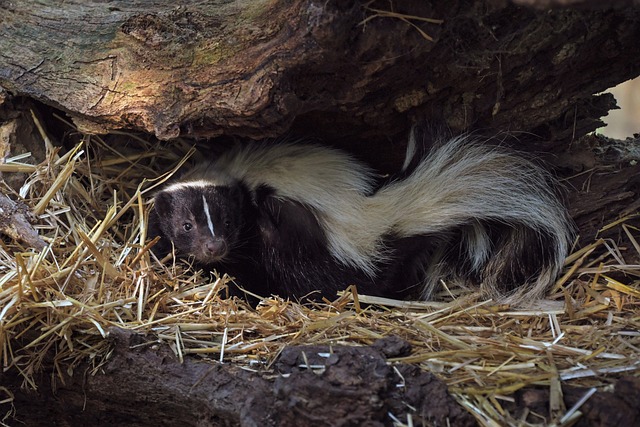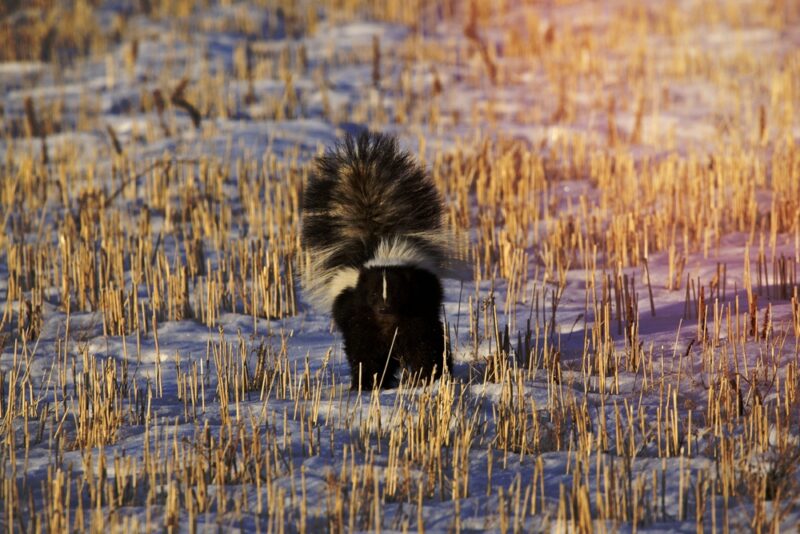Skunks are not classified as true hibernators. But they go into a state of torpor when the weather gets cold. Skunks are light sleep hibernators, along with opossums, bears, and raccoons.
Hibernation is a state of deep torpor, but not all torpor is a state of hibernation. We will explain below.
Skunk Behavior in Winter
State of Torpor
What do skunks do in the wintertime? These small mammals are common in rural and urban landscapes. They are known for their nocturnal habits and the powerful aroma they leave behind. If your dog has ever been sprayed by a skunk, you know what I’m talking about.
As the seasons change, so does a skunk’s behavior. In cold weather, they are less likely to rummage through your trash cans or pet food bowl at night. They don’t emerge from their winter dens in the coldest weather for days or weeks.
Instead, they enter a state of hypometabolic state called torpor.
Some animals go into torpor to cut down on energy costs when it’s cold or in times of food scarcity.
Some animals, such as marsupials, go through daily torpor. Daily torpor lasts for less than 24 hours, followed by continued foraging.
Torpor that lasts for a period over 24 hours is considered hibernation. Source
In the cold winter months, skunks go through extended torpor or hibernation. This means that they enter winter dens for a period of sleeping. During these sleep periods, their metabolism slows way down. This helps them to conserve energy during especially cold spells.
When you sleep each night, your metabolism slows down, too. Torpid animals take this to the extreme.
Thermoregulation is a term for internal body temperature regulation. Warm-blooded animals thermoregulate. Thermoregulation uses 40 to 60% of the energy an animal takes in. Source Torpor is a state where an animal’s metabolism slows way down. In medical terms, it’s a hypothermic, hypoactive, hypometabolic state. Animals go into torpor to reduce the calories they need to survive in adverse conditions.

Physiological Changes During Torpor
Torpor is a survival mechanism. Skunks utilize torpor to survive the cold and limited resources of the winter season.
When a striped skunk is in torpor, their body temperature drops from 100.4° to 89.6° Fahrenheit (38° to 32°C). Also, their heart rate slows down considerably, and they breathe at a much slower rate.
True hibernators’ body temperatures drop more than light sleep hibernators like skunks.
The arctic ground squirrel is an example of a true hibernator. Their normal body temperature is around 99° Fahrenheit (37° C). However, their temperature may go as low as 27° Fahrenheit (-2.77°C) during hibernation. Source
Duration and Frequency
Skunks enter torpor intermittently throughout the winter. They alternate between periods of deep sleep and brief periods of wakefulness. Usually, when it’s over 30 degrees Fahrenheit, they awaken to forage for food at night.
Also, skunks must empty out their scent glands at least once during the winter. If you come upon an area with a particularly foul skunk smell, this probably explains it. You might also see their florescent yellow to greenish yellow spray on the snow.
Another thing that brings skunks out from their winter dens is the search for a mate. Skunk mating season begins from mid-February to early March. If it is a mild February, male skunks will emerge from their dens earlier. If it’s particularly cold, they’ll stay in their torpid state into early March.

Winter Dens
As fall approaches, skunks seek out or dig winter dens. These are different dens than the ones they utilized during the summer. Male skunks are generally intolerant of each other. Most of the time, they den alone, while on rare occasions, they den with other male skunks. On the other hand, female skunks are more apt to share communal dens for extra warmth. Up to twelve females may share the same skunk den. Source
Different Types of Dens Skunks Utilize:
Ground Burrows. Skunks often dig burrows into the ground. These burrows not only provide insulation but also shield skunks from predators.
Crawl Spaces and Hollow Logs. Skunks may repurpose existing spaces like a crawl space under a building. Hollow logs also make likely spots for skunk dens. These spaces offer ready-made protection, and skunks adapt them to suit their needs.
Garden Sheds and Commercial Buildings. In urban areas, skunks may find refuge in man-made structures. These might include outbuildings such as a garden shed or commercial building. Any man-made structure not regularly utilized by humans is a potential skunk shelter. They will find a secluded corner and line it with dead grass to create a nest.
Creation of Thick Fat Layers for Insulation.
As winter approaches, skunks undergo a process called hyperphagia. This is characterized by a period of binge eating. This excessive eating allows them to accumulate substantial fat stores. The extra fat helps keep them warm. It also serves as a vital energy reserve during torpid periods.

Skunks in Different Seasons
Fall Months
As fall approaches, skunks start preparations for the impending winter. Hyperphagia, or binge eating, becomes pronounced, building fat reserves. Skunks also locate or construct their winter dens. They block ground burrow entrances with leaves and grass to provide extra insulation.
Cold Months
Skunks enter their winter dens. They enter a state of intermittent torpor called light sleep hibernation. This enables them to survive this period of cold and food scarcity.
Warmer Months
The mating season for skunks is in the early spring. Its exact timing depends on how quickly warmer temperatures arrive.
After mating, both male and female skunks work on restoring their lost body weight. On average, they will have lost about 30% of the weight they carried before entering their winter home.
Their diet shifts away from scavenging winter time carrion, pet food, and refuse.
In the summer months, skunks eat live food like insects, rodents, young birds, eggs, and fruit.
Longer days and milder temperatures encourage exploration and social interactions. Skunks are more visible in urban areas during this time.
Conclusion
Skunks do not qualify as true hibernators. However, they engage in a state of torpor during the coldest winter months. This period is called light sleep hibernation. It helps them conserve energy and survive harsh conditions. Skunks alternate between deep sleep and brief wakefulness. They forage for food when temperatures rise above 30 degrees Fahrenheit. Their winter dens serve as shelters during their torpid state. These may be ground burrows, crawl spaces, or man-made structures.
Physiologically, skunks undergo significant changes during torpor. These include a drop in body temperature, slower respiration, and a slower pulse rate. These changes are not as severe as the changes that true hibernators go through, though.
As winter transitions to spring, mating season prompts their emergence from dens. Warming weather also creates a shift in diet and activity. With their adaptable behaviors, skunks exemplify nature’s strategies for coping with seasonal challenges.
Recent Posts
The only venomous snakes in Washington State are Northern Pacific Rattlesnakes. The Northern Pacific Rattlesnake (Crotalus oreganus oreganus) is a sub-species of the Western Rattlesnake. Anyone...
Today, Connecticut has a viable fisher cat population over the entire state. This hasn’t always been the case, though. For a time, they were extirpated from the state. Fisher cats or fishers are a...
